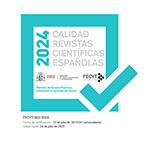Gender role in the theme of the double. Punishment, desire and social role in La piel que habito (Pedro Almodóvar, 2011), Laurence Anyways (Xavier Dolan, 2012) y Tomboy (Céline Sciamma, 2011)
Abstract
Introduction. This article explores the relationship between the theme of the double and gender, which is developed mainly in the splitting procedure by metamorphosis, where the characteristics of compatibility and personal identity typical of the classic double vary. Objetivos y metodología. In the analysis we will explore the different possibilities that arise in these stories, dwelling on the concept of personal identity –through the microtextual elements of the topic and on the variants of the unfolding provided by Doležel -paradigmatic, syntagmatic, authenticity and modes of construction. To do so, the films The Skin I Live In (La piel que habito, Pedro Almodóvar, 2011), Laurence Anyways (Xavier Dolan, 2012) and Tomboy (Céline Sciamma, 2011) will be analyzed. Results and conclusions. In conclusion, we observe that personal identity prevails over gender change or confusion, especially through microtextual elements: proper name and mask/disguise. The metamorphosis recreates mutually exclusive doubles in time and space, justifiably authentic, with points in common between the two and different modes of construction (desire, punishment and social role) based on the classics proposed by Kovacshazy. These films, therefore, coincide with Kuhn's premise on feminist cinema, making the invisible visible, narrating and problematizing —through a theme with as much tradition as that of the double, on issues not present on mainstream cinema.
Downloads
Article download
License
In order to support the global exchange of knowledge, the journal Investigaciones Feministas is allowing unrestricted access to its content as from its publication in this electronic edition, and as such it is an open-access journal. The originals published in this journal are the property of the Complutense University of Madrid and any reproduction thereof in full or in part must cite the source. All content is distributed under a Creative Commons Attribution 4.0 use and distribution licence (CC BY 4.0). This circumstance must be expressly stated in these terms where necessary. You can view the summary and the complete legal text of the licence.











